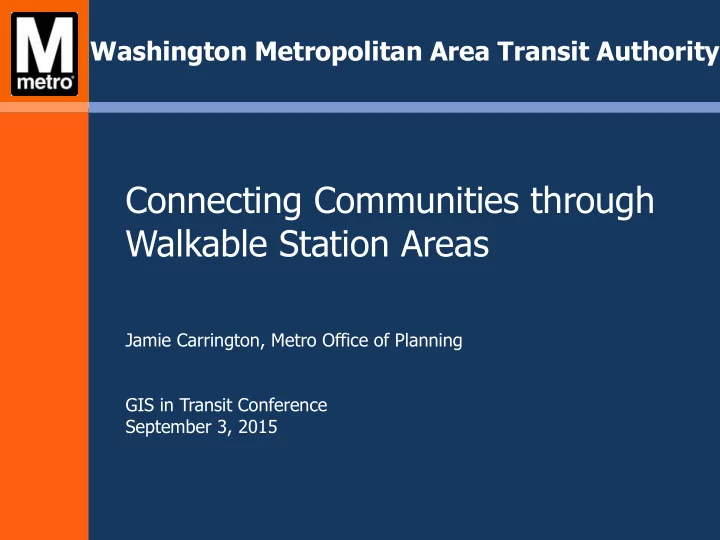

Washington Metropolitan Area Transit Authority Connecting Communities through Walkable Station Areas Jamie Carrington, Metro Office of Planning GIS in Transit Conference September 3, 2015
Agenda • Metro Background • Land Use, Connectivity and Ridership • Analyzing Station Walksheds with GIS 2
About Metro Governed by Compact of • DC/MD/VA/Federal Govt Service area covers 8 local • jurisdictions, 3.9M people Metrorail 91 Stations • 117 Track Miles • ~750,000 daily trips • #2 in North America Initial 5-line system built • 1969-2001
Station Contexts + Access Patterns
Transit-Oriented Development vs. Park and Ride Bethesda Daily Ridership: 11,500 Daily Revenue: $33,000 Daily Ridership: 6,300 Daily Revenue: $18,000 Suitland 5
Transit-Oriented Development vs. Park and Ride Bethesda 1000 900 Entries per Half Hour 800 700 600 500 400 300 200 100 0 Suitland
Land Use and Ridership Connection: Making the Case • Land use near transit directly results in walk ridership at Metrorail stations 10 Households in walkshed = 7 Peak Walk-Rail Trips
Connectivity and Ridership 8 Source: 2012 Metrorail Rider Survey
Connecting Communities Grow Near Improve Access Expand Transit Transit to Stations • Transit-oriented • Expand bus routes • Fix pedestrian development barriers • Build new • Zoning Metrorail lines and • Build paths and stations sidewalks • Planning ?
Why Connecting Communities Matters • Concentrating growth near transit maximizes use of regional infrastructure • Connecting communities to transit attracts more ridership • More ridership contributes to lower carbon footprints • Access to Metro means access to opportunity 10
GIS for Transit 101: Half Mile Buffers • Basic estimate of rail station access, ridership • Assumes direct, unimpeded ped access • Actual conditions ½ Mile depend on street grid, ~10 minute walk pedestrian infrastructure • Most applicable to dense urban street grids
Buffer vs. Actual Walking Paths • Suburban street grids: • Large blocks • Meandering streets • Disconnected grids • ½ Mi from station, but actual walking distance much greater ½ Mile? X • Missing pedestrian infrastructure
Station Walkshed • Area within a ½ mile walk using the actual pedestrian network • Generated by Service Area function of ArcGIS Network Analyst • Trip generators in buffer but not walkshed = potential ridership
Build the Network • OpenStreetMap streets – exclude tags: ‘motorway,’ ‘motorway link,’ etc • Other sources if available – eg, Fairfax Co sidewalk .shp • Create Manual layer – paths not in OSM • Create Barriers layer 14
Network Considerations • Street centerline vs. actual sidewalks 15
Network Considerations • Crosswalks and signals (or lack thereof) 16
Network Considerations • Informal paths 17
Network Considerations • Routes through private property, secured areas, parking lots 18
Run Service Area Analysis
Walkshed Ratio Columbia Heights 0.73 Landover 0.17
Opportunities to Expand Access: Jobs • 4,000 jobs cut off from Greensboro Station • Potential lost ridership: • 500 entries/day • $625,000 fares/year • Missing pedestrian infrastructure 4,000 jobs cut off from station
Opportunities to Expand Access: Households Southern Avenue Potential Fare Revenue ~$300,000 / year Existing Conditions Potential Future Path? 22
Walkshed Coverage Scores 23
Applications of Walkshed Analysis • Identify projects to improve access, grow walkshed • Prioritize • Implement projects on WMATA property • Incorporate into Joint Development • Advocate with local governments 24
WMATA Station Access Projects 25
Advocating for Access: Rhode Island Avenue Existing Barrier Potential to Expand Walkshed 26
Thank You 27
Recommend
More recommend